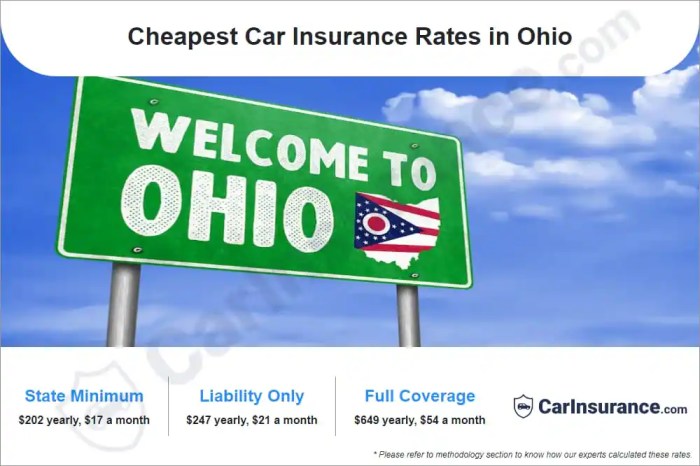Securing the right car insurance in Ohio can feel like navigating a complex maze. Understanding the state’s specific regulations, the various coverage options, and the factors influencing your premium is crucial for both financial protection and peace of mind. This guide aims to demystify the process, providing you with the knowledge to make informed decisions and find the best car insurance policy for your needs.
From understanding Ohio’s minimum insurance requirements to exploring ways to secure discounts and effectively file a claim, we’ll cover all the essential aspects of car insurance in the Buckeye State. We’ll delve into the impact of factors like driving history, credit score, and vehicle type on your premiums, equipping you with the tools to compare quotes and choose a policy that offers optimal value and coverage.
Understanding Ohio’s Car Insurance Laws
Driving in Ohio requires understanding the state’s car insurance regulations to ensure legal compliance and financial protection. Failure to comply can result in significant penalties and legal ramifications. This section details Ohio’s minimum insurance requirements, available coverage types, and potential costs.
Minimum Car Insurance Requirements in Ohio
Ohio mandates minimum liability coverage for bodily injury and property damage. This means drivers must carry insurance that covers the costs of injuries or damages they cause to others in an accident. The minimum requirement is $25,000 for bodily injury to one person, $50,000 for bodily injury to multiple people in a single accident, and $25,000 for property damage. These are the absolute minimums, and higher coverage limits are strongly recommended to protect against significant financial losses.
Types of Car Insurance Coverage Available in Ohio
Several types of car insurance coverage are available in Ohio beyond the minimum liability requirements. These options offer varying levels of protection against different types of accidents and damages.
Liability Coverage: This covers injuries and damages you cause to others. As mentioned, Ohio’s minimum is $25,000/$50,000/$25,000, but higher limits are advisable.
Collision Coverage: This covers damage to your vehicle, regardless of fault, in an accident. It pays for repairs or replacement of your car, even if you caused the accident.
Comprehensive Coverage: This covers damage to your vehicle from events other than collisions, such as theft, vandalism, fire, or weather-related damage.
Uninsured/Underinsured Motorist Coverage: This protects you if you’re involved in an accident with an uninsured or underinsured driver. It covers your medical bills and vehicle damage.
Medical Payments Coverage (Med-Pay): This covers medical expenses for you and your passengers, regardless of fault, following an accident.
Personal Injury Protection (PIP): This covers medical expenses and lost wages for you and your passengers, regardless of fault. Ohio is an “at-fault” state, meaning your own insurance will cover you regardless of who caused the accident, but PIP can help with this process.
Comparison of Insurance Costs in Various Ohio Cities
Insurance costs vary significantly across Ohio, influenced by factors such as population density, accident rates, and the cost of vehicle repairs. Precise cost comparisons require obtaining quotes from multiple insurers, but generally, larger cities like Columbus and Cleveland tend to have higher premiums than smaller towns due to increased risk factors. For example, a similar coverage policy might cost $100-$150 more per month in Columbus compared to a smaller city like Athens. Rural areas often have lower premiums due to lower accident rates and less traffic congestion. Individual driving history and credit score also significantly impact premiums.
Penalties for Driving Without Insurance in Ohio
Driving without insurance in Ohio is illegal and carries severe penalties.
| Violation | Fine | License Suspension | Other Penalties |
|---|---|---|---|
| First Offense | $500 – $1000 | Up to 90 days | Vehicle impoundment, court costs |
| Second Offense | $1000 – $1500 | Up to 1 year | Vehicle impoundment, court costs, possible jail time |
| Subsequent Offenses | $1500+ | Up to 1 year or more | Vehicle impoundment, court costs, possible jail time, mandatory SR-22 insurance |
Discounts and Savings on Ohio Car Insurance

Saving money on your Ohio car insurance is achievable through various discounts and smart strategies. Understanding these options and how to qualify can significantly reduce your premiums. This section details common discounts, how to obtain them, and the advantages of specific cost-saving measures.
Identifying and Obtaining Available Discounts
Many Ohio car insurance companies offer a range of discounts to incentivize safe driving and responsible insurance practices. These discounts often stack, meaning you can potentially qualify for multiple savings. To identify available discounts, carefully review your insurance company’s website or contact your agent directly. They can provide a personalized assessment of your eligibility for various programs. The application process typically involves providing supporting documentation, such as proof of completion for defensive driving courses or evidence of a good driving record.
Proving Eligibility for Discounts
Proving eligibility often involves submitting documentation to your insurer. For example, a good driver discount might require your driving record (obtained from the BMV), showing a clean history free of accidents and traffic violations for a specified period. Bundling discounts necessitate proof of other insurance policies (homeowners, renters) held with the same company. For discounts related to safety features in your vehicle (anti-theft devices, airbags), you will need to provide documentation showing these features are installed and functional. Defensive driving course completion certificates serve as proof of eligibility for that specific discount.
Benefits of Defensive Driving Courses
Enrolling in a state-approved defensive driving course offers significant benefits beyond just a potential reduction in your car insurance premiums. These courses enhance your driving skills, making you a safer driver and potentially reducing your risk of accidents. The knowledge gained can help you avoid costly accidents and tickets, leading to long-term savings beyond just the immediate insurance discount. Moreover, some employers may offer incentives for completing such courses, further adding to the overall value.
Common Car Insurance Discounts Offered in Ohio
Many discounts are available to Ohio drivers. Securing these discounts often involves simply informing your insurer and providing the necessary documentation.
- Good Driver Discount: Awarded to drivers with clean driving records, typically free of accidents and violations for a set period.
- Bundling Discount: Offered for combining multiple insurance policies (auto, home, renters) with the same company.
- Defensive Driving Course Discount: A reduction in premiums for completing a state-approved defensive driving course.
- Vehicle Safety Features Discount: Discounts are often available for vehicles equipped with safety features such as anti-theft devices, airbags, and anti-lock brakes.
- Multi-Car Discount: Insuring multiple vehicles under one policy often qualifies for a discount.
- Good Student Discount: Students maintaining a certain GPA may qualify for a discount.
- Payment Plan Discount: Paying your premium in full upfront can sometimes result in a discount.
SR-22 Insurance in Ohio

An SR-22 is not a type of insurance policy itself, but rather a certificate of insurance that proves you maintain the minimum required auto liability insurance coverage as mandated by the Ohio Bureau of Motor Vehicles (BMV). It’s a crucial document demonstrating your compliance with Ohio’s financial responsibility laws. This certificate acts as verification to the state that you are insured and helps ensure you can compensate others involved in accidents you may cause.
When an SR-22 is Required in Ohio
An SR-22 is typically required in Ohio after a driver has been convicted of certain driving offenses or has been involved in an accident resulting in significant damage or injury. These offenses can include driving under the influence (DUI), driving with a suspended license, reckless driving, or causing an accident without adequate insurance. The BMV will specify the duration for which the SR-22 is required as a condition of reinstating your driving privileges. The exact offenses and the length of the SR-22 requirement vary based on the severity of the violation and the driver’s history.
Obtaining an SR-22
To obtain an SR-22, you must contact an insurance provider that offers this service. Many insurance companies offer SR-22 filings. You’ll need to provide them with your driving record and other relevant information. The insurance company will then file the SR-22 electronically with the Ohio BMV on your behalf. This process involves providing the insurer with the necessary documentation and paying for the required insurance coverage. The cost will vary depending on your driving history, the type of vehicle you drive, and the coverage levels you choose. It’s important to remember that the SR-22 itself doesn’t add coverage, but rather confirms the existence of the minimum required liability insurance.
Implications of Not Maintaining an SR-22
Failing to maintain an SR-22 after it’s been mandated by the BMV will result in serious consequences. This can lead to the suspension or revocation of your driver’s license, further fines, and potential legal repercussions. It’s crucial to ensure that your SR-22 remains active throughout the entire period mandated by the BMV. Non-compliance could significantly impact your ability to legally drive in Ohio and may lead to additional fees and penalties.
Duration of SR-22 Requirement
The length of time an SR-22 is required varies depending on the severity of the offense and the individual’s driving history. It could range from one to three years, or even longer in some cases. The BMV will clearly state the required duration when issuing the order. It’s important to maintain continuous coverage and the active SR-22 filing throughout this entire period to avoid penalties. For example, a first-time DUI offender might have a three-year SR-22 requirement, while a repeat offender could face a longer period. The BMV’s website or contacting them directly is the best way to obtain the precise duration for a specific case.
Conclusive Thoughts

Successfully navigating the world of car insurance in Ohio requires careful planning and understanding. By familiarizing yourself with the state’s laws, exploring available coverage options, and actively seeking discounts, you can secure a policy that provides adequate protection without breaking the bank. Remember, proactive research and informed decision-making are key to finding the right car insurance for your individual circumstances. This guide serves as a starting point; always consult directly with insurance providers for personalized advice and accurate quotes.
FAQ Resource
What happens if I get into an accident and don’t have car insurance in Ohio?
Driving without insurance in Ohio is illegal and can result in significant penalties, including fines, license suspension, and even jail time. You’ll also be responsible for covering all accident-related costs yourself.
Can I get car insurance if I have a poor driving record?
Yes, but it will likely be more expensive. Insurance companies consider your driving history, so past accidents and violations will affect your premiums. You may need to shop around for insurers specializing in high-risk drivers.
How often can I expect my car insurance rates to change?
Your rates can change annually, or even more frequently, depending on your driving record, claims history, and other factors. Review your policy regularly and compare quotes to ensure you’re getting the best rate.
What is the difference between liability and collision coverage?
Liability coverage pays for damages to other people’s property or injuries they sustain in an accident you cause. Collision coverage pays for repairs to your own vehicle, regardless of fault.